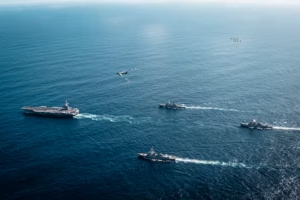The Struggles of the Treaty on the Prohibition of Nuclear Weapons
By Kira Webster
Supporters of the Treaty on the Prohibition of Nuclear Weapons – created about a year ago out of frustration concerning the 1968 Nuclear Non-Proliferation Treaty – hope it will create a path toward the banning of nuclear weapons. The TPNW bans using nuclear weapons as a threat and the development and transferring of them in any way. Its goal is to override the NTP and also take it one step further. Advocates of the treaty acknowledge that the plan will take years to bring to fruition, and they hope that the delegitimizing possession of nuclear weapons will turn of the pressure on countries not part of the treaty to give up their arsenals.
The NPT can be called a success in some respects, as the 50-year-old deal made demands from two different kinds of countries: countries that do not possess nuclear weapons cannot develop or receive them, and countries with nuclear weapons must “pursue negotiations in good faith on effective measures” towards nuclear disarmament. Since the implementation of NPT, the number of nuclear weapons dropped from 70,000 to about 14,458 today. However, the United States’ nuclear policy has shifted, and countries in possession of nuclear weapons have been accused of not upholding their side of the treaty. The fact that some countries, like our own, have been modernizing their weapons gives an indication that they intend on keeping their nuclear arsenals, which would defeat the purpose of the TPNW.
The trend toward nuclear modernization created a push for a new treaty, and the U.N. General Assembly called for negotiations on a nuclear ban treaty in the spring and summer of 2017. However, none of the nine countries believed to have nuclear weapons (including the United States) were present, and many of the non-possessing countries (including U.S. allies like South Korea, Japan, Canada, and Australia) didn’t show either. According to the countries that registered opposition, many details were lost. One of the largest criticisms was putting a ban on weapons would only leave negotiable countries empty-handed while authoritarian countries (i.e. North Korea) completely ignore the ban and potentially strike. Nevertheless, in July 2017, 122 countries voted to approve the final text on the treaty. To date, it has 69 signatories and 19 countries that chose to ratify.
The U.S., United Kingdom, France, Russia, and China have all declared that they will not be signing the treaty – which came as no surprise to the supporters. The movement for countries joining the treaty recently slowed. Some believe that many countries have started having second thoughts about the legal implications of the treaty, as there are concerns as to how it would affect the lifestyle and overall safety of their countries. Even the Marshall Islands – vocal, longtime supporters of nuclear disarmament – have not signed or ratified the treaty yet, which has made many question just how deep concerns go over the ban.
Beatrice Fihn, the executive director of International Campaign to Abolish Nuclear Weapons, contends that it will simply take time for governments to go through the legality of the concerns, especially for smaller countries. She said that it has gone through ratifications faster than any other nuclear weapons treaty so far, and has influenced important conversation about nuclear disarmament the world should be engaging in. Addressing concerns and criticisms over the lack of definitions and specificity in the treaty, she pointed out that many prior treaties did not have many definitions, and they were eventually encoded in to areas of international law.
A ban on nuclear weapons has been in concerned citizens’ and arms control advocates’ thoughts since WWII, and it’s possible that citizens will achieve that goal in the future. Currently, however, it will take time and a distinct path to ensure that this happens. Clear definitions, specifications, and expectations must be boldly expressed in any ban treaty. Opaque outlines and standards are too easy to manipulate, and it must be revisited frequently enough so it stays modern. Nuclear treaties with authoritarian countries should be established first before the world signs an all-encompassing one. Risks of leaving peaceful countries unable to defend themselves is a real threat, and unless there is full cooperation, a nuclear ban will not last long -no matter how many signatures and ratifications it undergoes.













